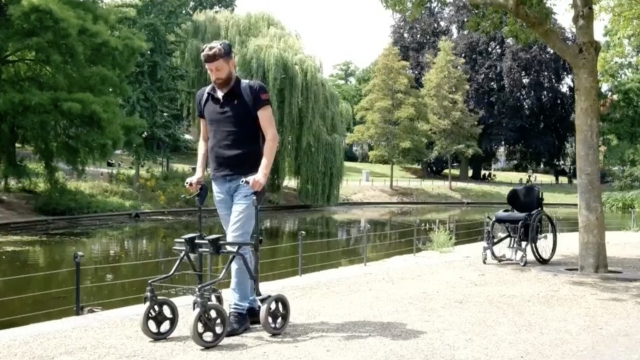Researchers from École Polytechnique Fédérale de Lausanne (EPFL) in Switzerland have been able to make a paralyzed man walk again on his own.
The groundbreaking work shown in a video news release took more than a decade of science, surgery, a strong Bluetooth connection and the patient's own thoughts.
"The most surprising thing I think happened after two days. Within 5 to 10 minutes I could control my hips," Gert-Jan Oskam, the paralyzed patient, said in footage provided by EPFL.
In the findings published in Nature, neuroscientists explained how when we move, our brains send signals to the nerves and muscles in our bodies. For paralyzed patients, a spinal cord injury cuts off that communication.
A year ago, surgeons implanted stimulation devices on top of the part of the brain that controls motor function, and on the spinal cord where leg movement is controlled.
They leveraged A.I. to modify the implants so they could essentially talk to each other in a wireless Bluetooth fashion, creating what the researchers call a digital bridge — or a brain-spine interface — that bypasses the severed area.
So when Oskam thinks about moving, he's in control.
"I am in full control of what the stimulation does, and that gives me a lot of freedom which I didn't have with previous therapy," Oskam said in the release.
"Not only could it leverage the digital bridge to control this paralyzed muscle, but also show a recovery of neurological function you have lost for many years," said Grégoire Courtine, a neuroscientist at EPFL.
More than 17,000 Americans suffer a new spinal cord injury each year.
Globally, the progress in spinal cord recovery has included some incredible science breakthroughs in the past year.
In the U.S., there has been a brain-computer interface, where researchers have used a similar implant technology to give a paralyzed man the ability to drive a car using his thoughts.
Scientists have also looked at using nanoparticles and patient-specific stem cells to regrow neurons key to the spinal cord. Getting to a fully restored spinal cord is still a long way off.
The next big steps will focus on how to take the big breakthroughs and make them more accessible for things like controlling wheelchairs and prosthetics.
SEE MORE: Man attempts marathon in robotic walking device
Trending stories at Scrippsnews.com




